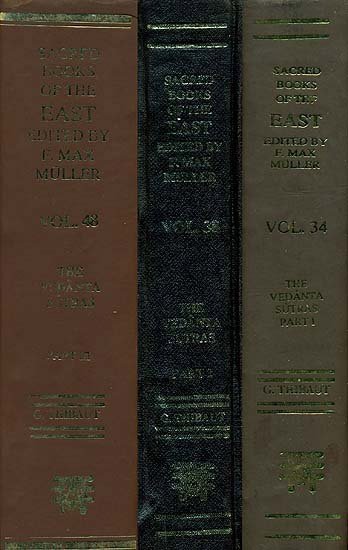Brahma Sutras (Ramanuja)
by George Thibaut | 1904 | 275,953 words | ISBN-10: 8120801350 | ISBN-13: 9788120801356
The English translation of the Brahma Sutras (also, Vedanta Sutras) with commentary by Ramanuja (known as the Sri Bhasya). The Brahmasutra expounds the essential philosophy of the Upanishads which, primarily revolving around the knowledge of Brahman and Atman, represents the foundation of Vedanta. Ramanjua’s interpretation of these sutras from a V...
Sutra 1.4.17
17. Should it be said that this is not so on account of the inferential marks of the individual soul and the chief vital air; we reply that this has been explained before.
With reference to the plea urged by the Pūrvapakshin that, owing to inferential marks pointing to the individual soul, and the circumstance of mention being made of the chief vital air, we must decide that the section treats of the enjoying individual soul and not of the highest Self, the Sūtra remarks that this argumentation has already been disposed of, viz. in connexion with the Pratardana vidyā. For there it was shown that when a text is ascertained, on the ground of a comprehensive survey of initial and concluding clauses, to refer to Brahman, all inferential marks which point to other topics must be interpreted so as to fall in with the principal topic. Now in our text Brahman is introduced at the outset 'Shall I tell you Brahman?' it is further mentioned in the middle of the section, for the clause 'of whom this is the work' does not refer to the soul in general but to the highest Person who is the cause of the whole world; and at the end again we hear of a reward which connects itself only with meditations on Brahman, viz. supreme sovereignty preceded by the conquest of all evil. 'Having overcome all evil he obtains pre-eminence among all beings, sovereignty and supremacy—yea, he who knows this.' The section thus being concerned with Brahman, the references to the individual soul and to the chief vital air must also be interpreted so as to fall in with Brahman. In the same way it was shown above that the references to the individual soul and the chief vital air which are met with in the Pratardana vidyā really explain themselves in connexion with a threefold meditation on Brahman. As in the passage 'Then with this prāṇa alone he becomes one' the two words 'this' and 'prāṇa' may be taken as co-ordinated and it hence would be inappropriate to separate them (and to explain 'in the prāṇa which abides in this soul'), and as the word 'prāṇa' is ascertained to mean Brahman also, we must understand the mention of prāṇa to be made with a view to meditation on Brahman in so far as having the prāṇa for its body. But how can the references to the individual soul be put in connexion with Brahman?—This point is taken up by the next Sūtra.
